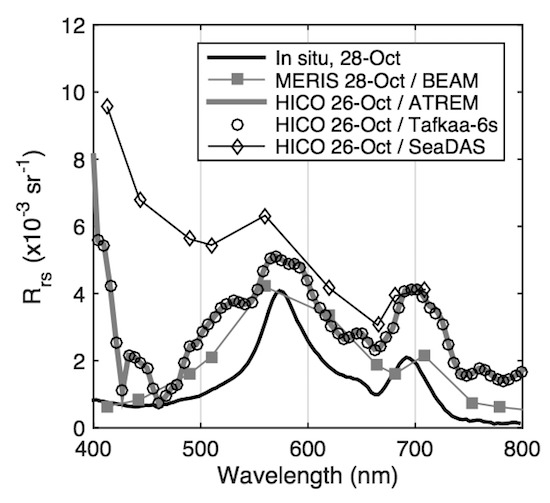Correction: Ryan, J., et al. Application of the Hyperspectral Imager for the Coastal Ocean to Phytoplankton Ecology Studies in Monterey Bay, CA, USA. Remote Sens. 2014, 6, 1007–1025

Acknowledgments
Author Contributions
Conflicts of Interest
References
- Ryan, J.P.; Davis, C.O.; Tufillaro, N.B.; Kudela, R.M.; Gao, B.-C. Application of the hyperspectral imager for the coastal ocean to phytoplankton ecology studies in Monterey Bay, CA, USA. Remote Sens. 2014, 6, 1007–1025. [Google Scholar] [CrossRef]
- Gao, B.-C.; Davis, C.O. Development of a line-by-line-based atmosphere removal algorithm for airborne and spaceborne imaging spectrometers. Proc. SPIE 1997. [Google Scholar] [CrossRef]
- Montes, M.J.; Gao, B.-C.; Davis, C.O. NRL Atmospheric Correction Algorithms for Oceans: Tafkaa User’s Guide; NRL Report NRL/MR/7230-04-8760; NRL: Washington, DC, USA, 2004; Available online: http://www.dtic.mil/cgi-bin/GetTRDoc?AD=ADA422068 (accessed on 17 July 2015).
© 2015 by the authors; licensee MDPI, Basel, Switzerland. This article is an open access article distributed under the terms and conditions of the Creative Commons Attribution license (http://creativecommons.org/licenses/by/4.0/).
Share and Cite
Montes, M.J.; Ryan, J.P.; Davis, C.O.; Tufillaro, N.B.; Kudela, R.M. Correction: Ryan, J., et al. Application of the Hyperspectral Imager for the Coastal Ocean to Phytoplankton Ecology Studies in Monterey Bay, CA, USA. Remote Sens. 2014, 6, 1007–1025. Remote Sens. 2015, 7, 13364-13366. https://doi.org/10.3390/rs71013364
Montes MJ, Ryan JP, Davis CO, Tufillaro NB, Kudela RM. Correction: Ryan, J., et al. Application of the Hyperspectral Imager for the Coastal Ocean to Phytoplankton Ecology Studies in Monterey Bay, CA, USA. Remote Sens. 2014, 6, 1007–1025. Remote Sensing. 2015; 7(10):13364-13366. https://doi.org/10.3390/rs71013364
Chicago/Turabian StyleMontes, Marcos J., John P. Ryan, Curtiss O. Davis, Nicholas B. Tufillaro, and Raphael M. Kudela. 2015. "Correction: Ryan, J., et al. Application of the Hyperspectral Imager for the Coastal Ocean to Phytoplankton Ecology Studies in Monterey Bay, CA, USA. Remote Sens. 2014, 6, 1007–1025" Remote Sensing 7, no. 10: 13364-13366. https://doi.org/10.3390/rs71013364
APA StyleMontes, M. J., Ryan, J. P., Davis, C. O., Tufillaro, N. B., & Kudela, R. M. (2015). Correction: Ryan, J., et al. Application of the Hyperspectral Imager for the Coastal Ocean to Phytoplankton Ecology Studies in Monterey Bay, CA, USA. Remote Sens. 2014, 6, 1007–1025. Remote Sensing, 7(10), 13364-13366. https://doi.org/10.3390/rs71013364





